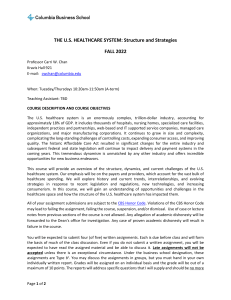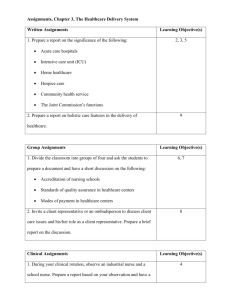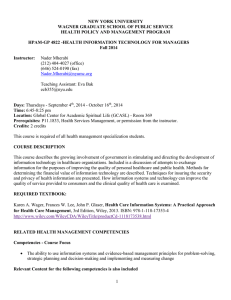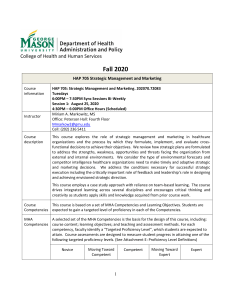THE U.S. HEALTHCARE SYSTEM B8117 FALL 2013
advertisement
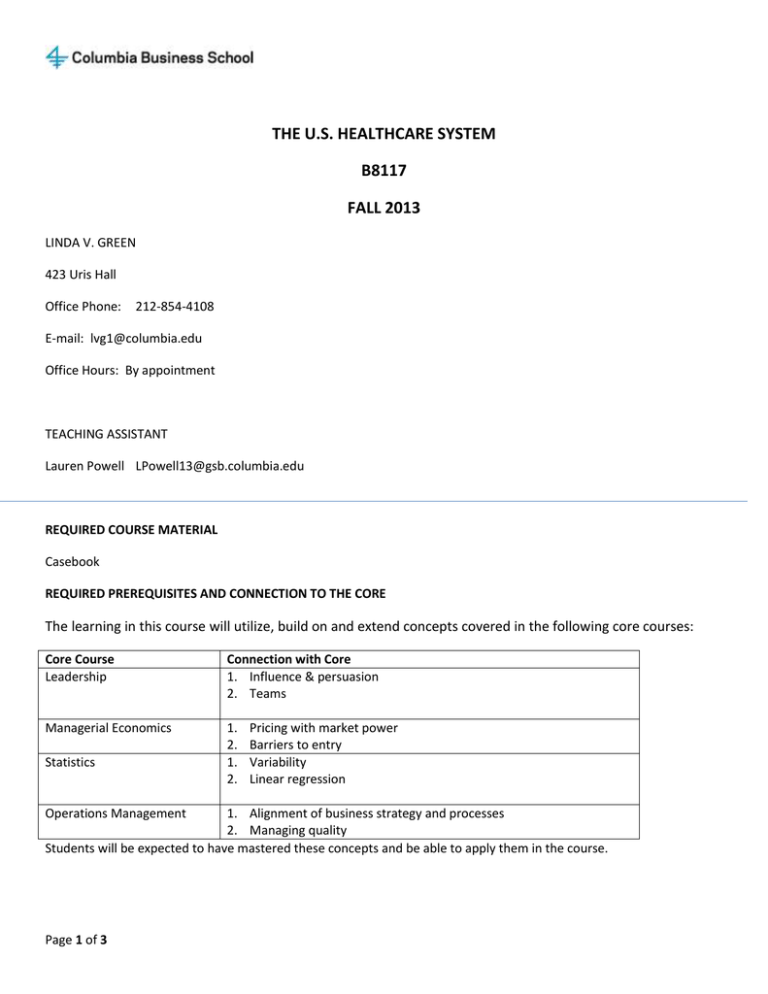
THE U.S. HEALTHCARE SYSTEM B8117 FALL 2013 LINDA V. GREEN 423 Uris Hall Office Phone: 212-854-4108 E-mail: lvg1@columbia.edu Office Hours: By appointment TEACHING ASSISTANT Lauren Powell LPowell13@gsb.columbia.edu REQUIRED COURSE MATERIAL Casebook REQUIRED PREREQUISITES AND CONNECTION TO THE CORE The learning in this course will utilize, build on and extend concepts covered in the following core courses: Core Course Leadership Connection with Core 1. Influence & persuasion 2. Teams Managerial Economics 1. 2. 1. 2. Statistics Operations Management Pricing with market power Barriers to entry Variability Linear regression 1. Alignment of business strategy and processes 2. Managing quality Students will be expected to have mastered these concepts and be able to apply them in the course. Page 1 of 3 COURSE DESCRIPTION The U.S. healthcare system is an enormously complex, trillion-dollar industry. It includes thousands of hospitals, nursing homes, specialized care facilities, independent practices and partnerships, web-based and IT supported service companies, managed care organizations, and major manufacturing corporations. Healthcare is the fastest growing component of many consulting practices and investment portfolios. In dollar terms, it accounts for almost 18% of GDP and is larger than the total economy of Italy. It continues to grow in size and complexity, complicating the long-standing problems of increasing costs, limited consumer access, and inconsistent quality. And, the historic health reform bill that was upheld by the U.S. Supreme Court last year will have major implications for years to come. This tremendous dynamism is unmatched by any other industry and offers incredible opportunities for new business endeavors. This course will provide an overview of the fast-evolving U.S. healthcare industry, the major players involved in the production and delivery of healthcare, and the key challenges and opportunities presented by new technologies, financing mechanisms, business models, and the political and regulatory developments engendered by recent legislation. COURSE OBJECTIVES Examine the factors and forces shaping the health care industry. Provide an overview of the major players and their interactions. Identify major trends and likely developments. Analyze the biggest challenges with respect to creating more cost-efficient and effective healthcare services and products. Facilitate the evaluation of new health care initiatives in light of all of the above. ASSIGNMENTS There will be 5 written case assignments. You may discuss these in your groups, but you must hand in your own individually written report. Grades will be assigned on an individual basis and the grade will be out of a maximum of 7 points. The reports will address specific questions that I will supply for each case and should be no more than 2 pages. The cases are: Medtronics Dana Farber Virginia Mason Intermountain Healthcare Heartport Page 2 of 3 METHODS AND MATERIALS All readings and cases are contained in the course pack. Additional readings and assignments will be handed out in class as needed. The course involves a mixture of lectures, case discussions and presentations by prominent guest speakers. The workload consists of class participation, case assignments, and a take-home final exam. Course grading will be based on the following evaluation weights: Participation Case Assignments Final Exam 25% 35% 40% CLASSROOM NORMS AND EXPECTATIONS Lectures, guest speakers, and class discussions are the major vehicles for learning the material. Therefore, it is imperative that you attend all classes, arrive on time, and give speakers and your fellow classmates your full attention. If you cannot attend a specific class or have to arrive late or leave early, let me know in advance by email. Please refrain from using laptops, IPads, cellphones, etc. in class. You will be given session guides for all classes and you can use these to take notes. Page 3 of 3
